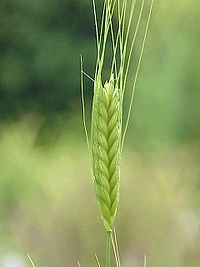
Photo from wikipedia
Celiac disease or gluten-dependent enteropathy is a chronic autoimmune pathology triggered by dietary gluten in genetic predisposed individuals, mediated by transglutaminase 2 IgA autoantibodies and associated with a deteriorating immune… Click to show full abstract
Celiac disease or gluten-dependent enteropathy is a chronic autoimmune pathology triggered by dietary gluten in genetic predisposed individuals, mediated by transglutaminase 2 IgA autoantibodies and associated with a deteriorating immune and inflammatory response. This leads to intestinal villous atrophy, impairing the intestinal mucosa structure and function of secretion, digestion, and absorption. The result is macro- and micronutrient deficiency, including fat soluble vitamins and minerals, and a consequent nutritional status depletion. A lifelong gluten-free diet is the only available treatment for celiac patients in order to assure normal intestinal mucosa and remission of gastrointestinal symptoms. However, a gluten-free diet can itself cause other nutritional deficiencies due to its restrictive nature regarding gluten-containing cereals. A group of gluten-free cereals, known as pseudocereals, is increasingly recognized as valuable options for gluten-free diets due to their high nutritional value. Amaranth, quinoa, millet, and buckwheat are examples of gluten-free nutrient-dense grains that can be used as alternatives to the conventional gluten-containing grains and improve the variety and nutritional quality of the celiac diet. Current work reviews the nutritional pitfalls of a gluten-free diet and analyses how pseudocereals can contribute to revert those deficiencies and optimize the nutritional value of this mandatory diet for the celiac population.
Journal Title: Journal of Nutrition and Metabolism
Year Published: 2022
Link to full text (if available)
Share on Social Media: Sign Up to like & get
recommendations!